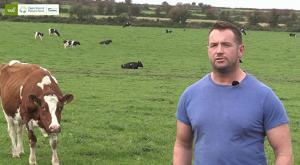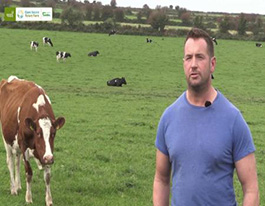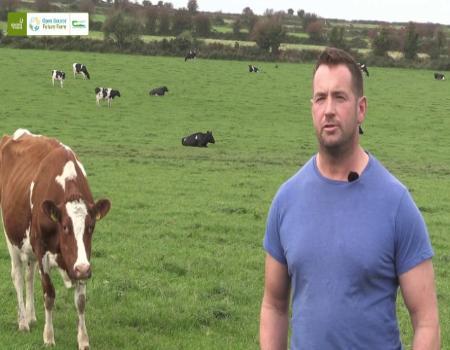Farm Update October 2023
 Shay Ryan is farming outside New Ross in Co. Wexford. Shay farms 97 Ha. The milking platform is 56Ha. There is also a small beef enterprise on the farm. Shay is currently milking an average of 180 cows & has 45 replacement heifers. The EBI of the herd is €213 & the young stock have an EBI of €261 and €271. In 2022 he supplied 468kg MS/cow & the plan is to raise this to 500Kg.The soil fertility on the milking platform has been improved to Index 3 and 4 for P and K and the farm grew 15.7 tonnes of grass DM/Ha in 2022. Shay aims to reseed 10% of the milking platform every year. This year he went with the PPI grass Nashota and 1.5kgs white clover seed.
Shay Ryan is farming outside New Ross in Co. Wexford. Shay farms 97 Ha. The milking platform is 56Ha. There is also a small beef enterprise on the farm. Shay is currently milking an average of 180 cows & has 45 replacement heifers. The EBI of the herd is €213 & the young stock have an EBI of €261 and €271. In 2022 he supplied 468kg MS/cow & the plan is to raise this to 500Kg.The soil fertility on the milking platform has been improved to Index 3 and 4 for P and K and the farm grew 15.7 tonnes of grass DM/Ha in 2022. Shay aims to reseed 10% of the milking platform every year. This year he went with the PPI grass Nashota and 1.5kgs white clover seed.
Paddocks
It’s hard to imagine we’ve started to grow our spring grass now. We started to close paddocks on 10th October. First paddocks closed were furthest away paddocks as this was handiest. They are dry and have ok access for grazing. These are the paddocks that will be grazed from 10th March so they will have plenty of time to build cover on them (Teagasc research showed that every week delay in closing reduces spring grass supply by 100kg DM/ha). The aim is that these paddocks will have a cover of around 1200 kg DM/ha on them when being grazed in spring. At that stage there will be a good mob of cows calved and adjusted to grazing so they will be able to deal with the level of cover. The second lot of paddocks to be closed will be dry paddocks near the yard for the first cows to be turned out. We are lucky as our land is very dry so have a good amount to choose from and have worked to ensure we have plenty of access to these. These will be grazed first and the cover needs to be lighter (800-1200 kg DM/ha) to give the cows a chance to get accustomed to grass in the diet again and get a good graze out. It also helps to get through a larger percentage of paddocks grazed off earlier which will give paddocks time to recover and ensure there is enough grass back for the second round of grazing. Among the last to be closed will be anything with clover – we are leaving them to last to give the clover a chance over the winter. Clover did really well this year. Even paddocks not noted for clover had a big increase. We don’t exactly know why, maybe the drought period in May/June meant that we didn’t get the peak growths until later this year and the clover had being given a chance to get strong enough to compete with the grass. Also, in the last few years we are being more strategic with use of P&K fertiliser and slurry which will have contributed as clover needs good P and K and pH levels.
Spring Grass
I know from talking to other farmers and from discussion groups a lot of farmers aren’t thinking of spring grass now and will say they just will keep grazing until all the grass is gone and then house the cows. However for a spring calving herd grass in spring is worth more to us than grass in autumn (maybe €1/cow/day?) so for us the grass year starts now. Weather permitting we are trying to graze down to a residual of 4 cm now. This will stimulate growth throughout the winter and avoid the carryover of dead material. The strip wire is used for heavy covers and when conditions are very wet. The target is to have 65% closed by November 1st – this won’t be a problem this year as we found it hard to build up cover this autumn and cows are flying through grass with the lower dry matters.
PastureBase
Someone once said to me to ‘look at the grass not the litres in the bulk tank’. It’s what is in front and behind them in the paddock that will sort the milk in the tank. We are measuring grass for nearly a decade now and are using Pasturebase for around five years. I have the app on my phone and it’s a super job as it’s so easy to use. I use in the field when doing a grass measure and even when I’m bringing in cows I can enter the date they came out the paddock. More recently I’ve started to use it to track fertiliser and slurry applications. Pasturebase had some great reports which show how each paddock is performing, how many grazings or silage cuts was taken off each paddock during the year, growth during different seasons etc. They say knowledge is power. Grass measuring gives me the knowledge – it’s up to me to use it!


